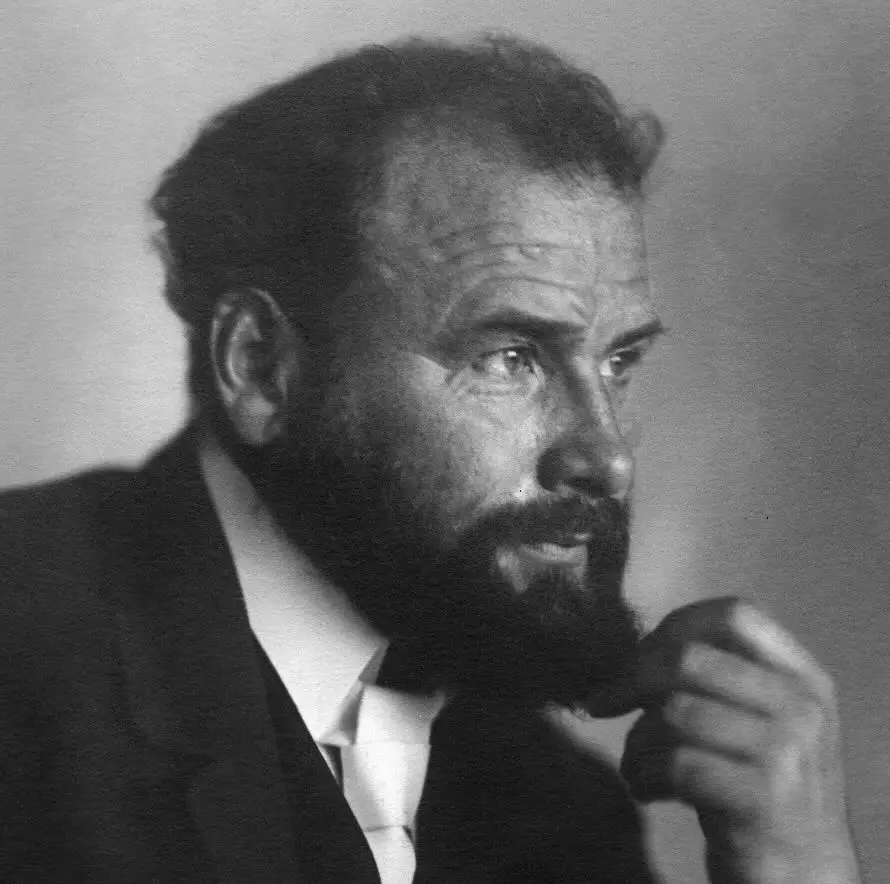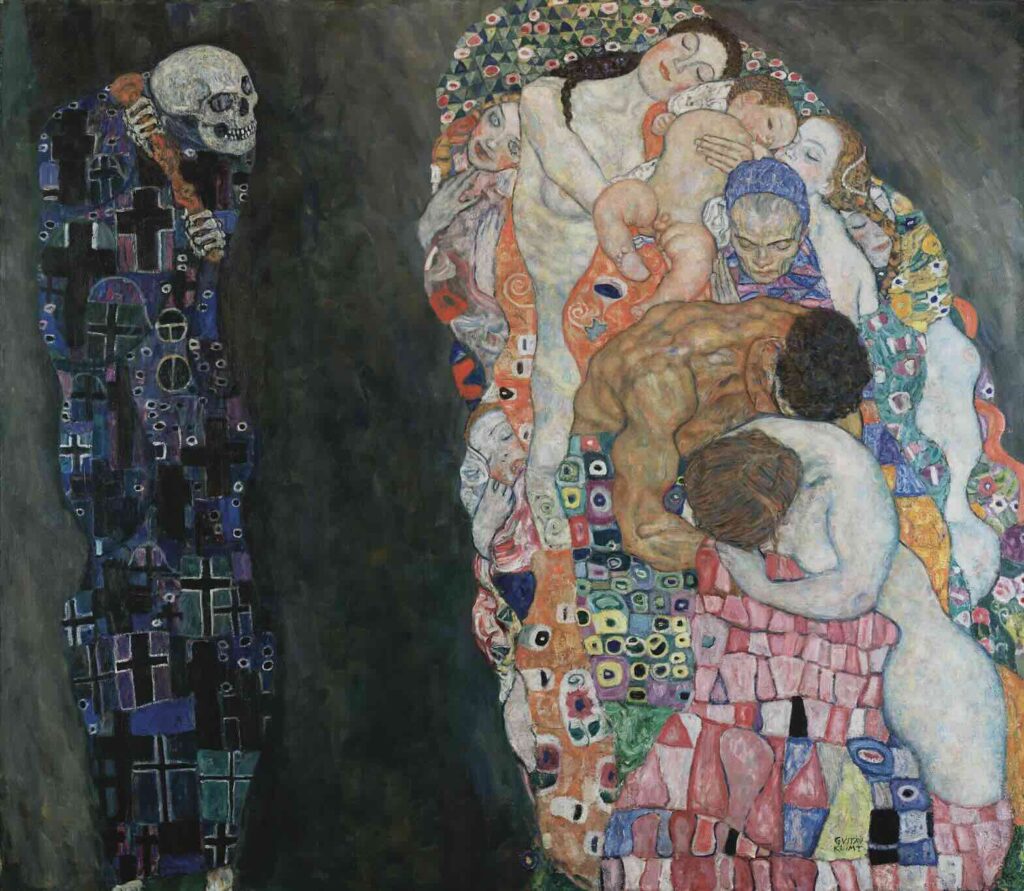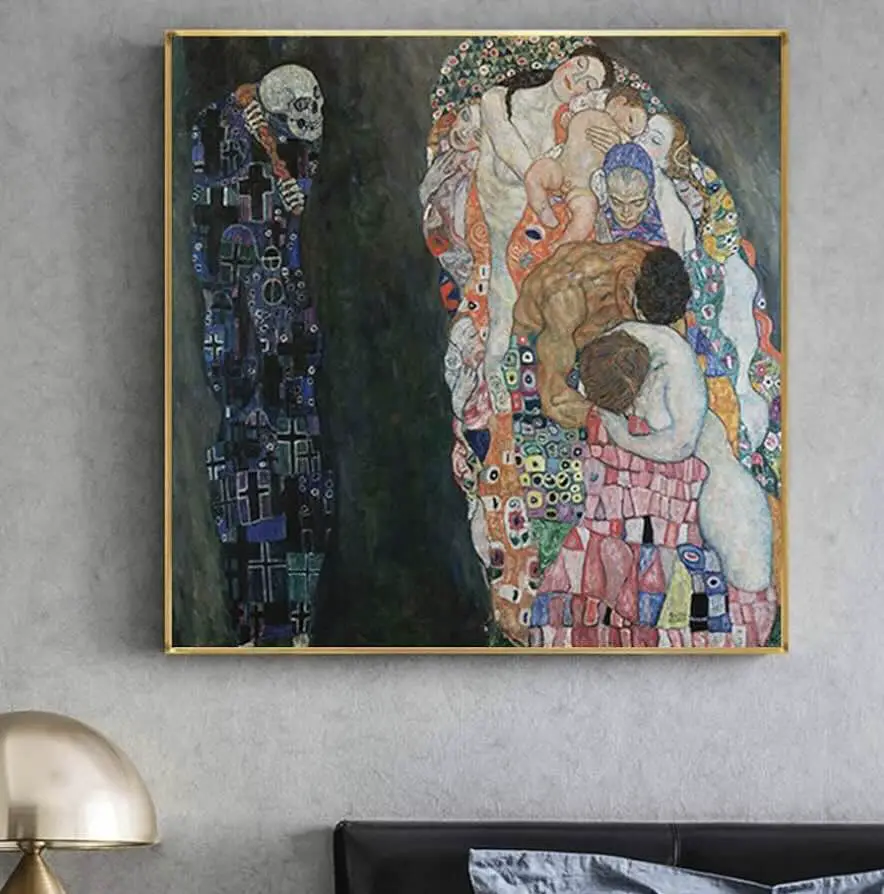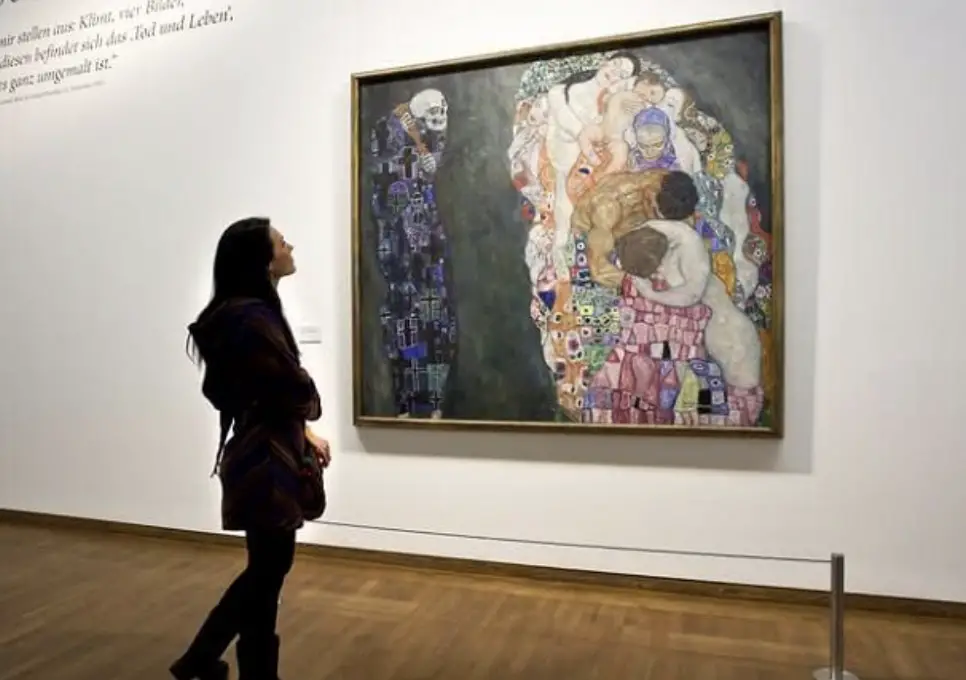Gustav Klimt, the Austrian symbolist painter renowned for his provocative, erotically charged, and gold-laden paintings, created a legacy that continues to captivate art enthusiasts worldwide.
Among his plethora of masterpieces, “Death and Life” is a significant beacon, embodying the quintessence of his artistic exploration. Read on as our exploration delves into the depths of “Death and Life,” unraveling its mysteries and understanding why it is considered a seminal work in Klimt’s oeuvre.
Table of Contents
- Gustav Klimt: The Artist And His Era
- “Death And Life”: The Masterpiece
- The Legacy Of “Death And Life”
- Related Questions
Gustav Klimt: The Artist And His Era

Born in 1862 in Baumgarten, near Vienna, Gustav Klimt was a central figure in the Vienna Secession movement. His often controversial work broke free from the traditional academic art of his time, introducing bold, symbolic, and often sensual imagery.
Klimt’s style evolved through various phases, with his “Golden Phase” being the most celebrated. He created works that would redefine modern art during this period and after that, including “Death and Life.
“Death And Life”: The Masterpiece

Created in 1910 and reworked in 1915, “Death and Life” is a remarkable painting that captures the eternal struggle between life and death. The painting is distinct in composition, featuring two primary figures: “Death” on the left and “Life” on the right.
The Composition
The figure of Death is depicted as a menacing, skeletal form draped in a robe decorated with symbols. Its ominous presence looms over the canvas, staring directly at the viewer with hollow eyes, holding a club, symbolizing its inevitable power.
In stark contrast, the right side of the painting swirls with vibrant colors, depicting Life. This portion is filled with people of various ages and genders intertwined in an almost dreamlike embrace. The figures seem blissfully unaware of Death’s presence, symbolizing the often-ignored inevitability of mortality.
Color And Technique
Klimt’s use of color in “Death and Life” is particularly striking. While Death is rendered in cold, dark hues, the figures representing Life are painted in warm, vivid colors. This juxtaposition is visual and symbolic, emphasizing the contrast between the two existential states.
The technique used by Klimt in this painting is also noteworthy. He employs his signature mosaic-like patterns, especially in the depiction of Death, and a more fluid, almost impressionistic style for the Life portion, showcasing his versatility as an artist.
Symbolism And Interpretation
“Death and Life” is rich in symbolism, a characteristic feature of Klimt’s work. The painting is open to multiple interpretations, each adding a layer of complexity to its understanding.
The Eternal Cycle
At its core, the painting reflects the eternal cycle of existence. Death and Life are portrayed not as opposing forces but as coexisting elements in a perpetual dance. Klimt’s portrayal of Death, looming yet passive, suggests an acceptance of its inevitability, while Life, vibrant and intertwined, symbolizes the beauty and complexity of human existence.
Psychological Interpretation
From a psychological perspective, the painting can be seen as a representation of the human subconscious grappling with the concept of mortality. The serene expression on the faces of the figures in Life contrasts sharply with the grim presence of Death, possibly reflecting the human tendency to remain oblivious to our mortality.
Artistic And Cultural Significance
“Death and Life” was painted when Europe underwent significant cultural and political changes. The painting can be seen as Klimt’s commentary on the fragility of Life in an era marked by uncertainty and transformation.

The Legacy Of “Death And Life”
The significance of “Death and Life” in Klimt’s work and the broader context of art history cannot be overstated.
Influence On Modern Art
Klimt’s bold symbolism and departure from traditional realism paved the way for modern artistic expressions. Death and Life” is a testament to this transition, influencing generations of artists who sought to explore existential themes.
Recognition And Awards
“Death and Life” received the first prize at the world exhibitions in Rome in 1911, further cementing Klimt’s status as a leading artist of his time. This accolade recognized the painting’s artistic merit and its profound thematic depth.
Contemporary Relevance
The painting remains relevant in contemporary discourse, resonating with audiences who grapple with the same existential questions today. Its allure lies in its timeless exploration of life and death, themes that remain central to the human experience.

Gustav Klimt’s “Death and Life” is more than just a painting; it is a philosophical exploration, a visual symphony of colors and patterns, and a testament to the artist’s genius. Its significance lies
In its ability to provoke thought, evoke emotion, and challenge the viewer’s perception of Life and death. As a cornerstone of Klimt’s legacy, “Death and Life” remains an enduring symbol of the transformative power of art, a masterpiece that continues to inspire and awe in equal measure.
Anita Louise Art is dedicated to art education, great artists, and inspiring others to find and create their art. We love art that uplifts and inspires. #ArtToMakeYouSmile! #ArtToMakeYouHappy!
If you want to see any of my art, you can find out more by clicking here. If you are interested in what inspires me and my paintings, you can discover more by clicking here.
We have a free newsletter and would love you to be part of our community; you can subscribe to the newsletter by clicking here. If you have any questions, I would be happy to talk to you. You can reach me, Anita, by clicking here.
Subscribe to our Anita Louise Art YouTube Channel, filled with great videos and information by clicking here.
Join us for our podcast “5 Minutes With Art.” Spend just 5 minutes a week with us to discover and learn about great art and artists. You can find out more about our podcast by clicking here.
Related Questions
Unlocking The Secrets Of Gustav Klimt’s Iconic Kiss
The Kiss is one of Gustav Klimt’s most celebrated artworks; it was painted from 1907 to 1908. The painting is filled with intricate details and gold leaf. The Kiss by Gustav Klimt depicts a couple locked in a passionate embrace, with the man kissing the woman on her cheek. The painting shows Gustav Klimt’s unique artistic style.
By clicking here, you can learn more by reading Unlocking The Secrets Of Gustav Klimt’s Iconic Kiss.
Gustav Klimt’s Paintings: An Intimate Glimpse Into His Genius
Gustav Klimt is widely regarded as one of the most influential artists of the 20th century. His innovative and daring approach to art and unique style and vision have made him an icon in modern art. Klimt’s paintings are celebrated for their sensuality, symbolism, and intricate details, which have captivated audiences for over a century.
By clicking here, you can learn more by reading Gustav Klimt’s Paintings: An Intimate Glimpse Into His Genius.
The Timeless Legacy Of Gustav Klimt’s Paintings
Gustav Klimt was a groundbreaking Austrian artist whose work continues to captivate audiences worldwide. His bold and innovative approach to art and his use of symbolism and sensuality have made him one of the most iconic artists of the modern era. Klimt’s legacy has profoundly influenced the art world and continues to inspire artists today.
By clicking here, you can learn more by reading The Timeless Legacy Of Gustav Klimt’s Paintings.


